1
Section One: The Fundamentals
A) What do we know about sport? What are common assumptions we make about sport and society?
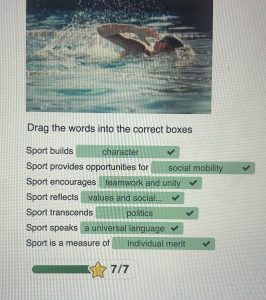
| When I saw the statement, sports reflect social values and norms I automatically wanted to critique it. I feel that it is very important to understand that sport does not always reflect people’s social values and norms because sport often reflects the culture it is situated in. Sports and the rules and actions associated with them do not reflect all cultures therefore every sport in some way will go against certain cultures’ social values and norms. Growing up I had friends who were of many different ethnic groups and religions. These peers were not allowed to participate in certain sports and leisure activities taught in school because it went against their values and norms. For example these women were not allowed to partake in any type of violence, therefore any contact sports were off the table for them. However they were allowed to participate in other non-violent sports like Dance, and tennis. This shows that not all sports can follow the social values and norms of all people. I also find it important to recognize that practice/game times for these sports were also held during important prayer times, therefore my peers could not participate in sports and stay loyal to their religion at the same time. This is unfair. I find that many sports in Canada at least, are often catered to white, catholic individuals which means that these sports often reflect the norms of only this group, neglecting anyone else. Along with this, Sports often promote violence, masculinity, and more which many people do not value in their own personal lives. No matter someone’s race, gender, ethnicity etc.. People have their own beliefs that contradict the social norms and values that sports instill. Therefore, the whole statement of sport reflecting social values and norms is false. It is important to note that just because a large number of people share the same values and norms sports do not as a whole reflect everyone’s unique thoughts. |
Exercise 3: Notebook prompt
What are some other metanarratives about sport that you are familiar with? Find an image or video clip or draw something yourself that captures this idea…
So what? Why does any of this matter? Does it matter? As something we grow up with – live with – play through – we don’t often interrogate the meanings of sport, and perhaps we don’t want to.
But being aware of these assumptions and metanarratives is especially important, I would argue, because of the centrality of sport to our everyday lives, the role that sport plays in shaping our childhood and worldviews and….. [finish that thought]
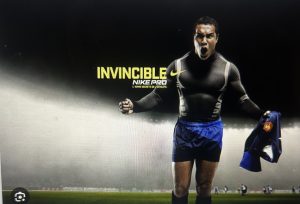
The first metanarrative that comes to mind is that Sport is a reflection of masculinity. Sports are often associated with masculinity because they perpetuate ideas about toughness, strength, and emotional suppression which are often associated with being a male. From a young age male athletes are taught that the tougher they are, and the more sports they play, will hold a role in deciding if people think they are masculine enough and fit a masculine ideal. This also goes along with the metanarrative that violence is acceptable in sport. Physical strength, toughness, and aggression are almost always celebrated in sport. These traits have been deemed necessary for success in the sporting world and have become traits to prove one’s masculinity. Everyone has come to the conclusion that violence is normal in sport and the more violent a male athlete is the more respected they are. These metanarratives are very problematic as they marginalize many people in sport that do not follow these standards. The image pasted here shows a Nike ad with the word invincible beside a strong male athlete. This captures the idea that sports reflect masculinity because it shows just a man. The photo fails to show any women or gender nonconforming people, making it seem like these people cannot be good at sport or “invincible” like the picture says. I find that most sports ads just include male athletes which is unfair and unequal. Ads like this need to change in order to create a more equal sporting environment for all. So why does this metanarrative matter? I think this metanarrative matters because it has significant cultural influence on people in everyday life. Sport as a reflection of masculinity, reinforces gender roles that affect our everyday lives. This metanarrative impacts how men and women are expected to do gender in both sports and everyday life which creates inequalities. For me especially this metanarrative has impacted my identity and I know it has impacted many of my peers identities as well. Growing up sports shaped my identity. The idea that you had to be inherently masculine to succeed impacted my overall experience with sport. My father pushed me to suppress my emotions, and toughen up because he believed that holding these masculine traits was the only way to succeed in the sporting world. This impacted my overall identity and made me think less of myself which is why this metanarrative can be so much of an issue. Overall, this idea of masculinity can cause serious exclusion in the sporting world and needs to be critiqued to reveal its true impacts. But being aware of these assumptions and metanarratives are especially important, I would argue, because of the centrality of sport to our everyday lives, the role that sport plays in shaping our childhood and worldviews and…… [finish that thought] because it informs how we understand our own identities and belonging in the world.
|
B) What is social justice?
Exercise 4: Padlet Prompt
Think back to the last section and try to look at some of the ideas we discussed differently. How might sport and social justice actually co-exist?
Record any images, video clips, or gifs you added to the padlet and identify a point of intersection between sport and social justice (can be an issue or a barrier or a debate or something you would like to explore in more depth in this course) . Screenshot or paste in your response below.
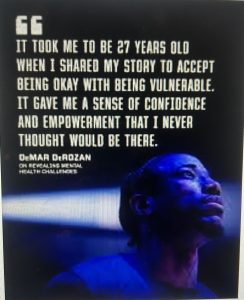 This quote/photo I added here is of NBA athlete Demar Derozan. Derozan shows how sport can be linked with social justice and advocacy and activism. I also think it is important to note that this topic could also be placed under the Health and Well-being section. For a long time Demar Derozan suffered from mental health issues and was afraid to seek help due to stigmatization and societal norms, but instead of staying quiet forever he decided to speak out and break the stigma. Demar Derozan not only wrote a book on his struggles but also spoke out on many different platforms to dismantle harmful stereotypes and stigmas associated with mental health. Derozan’s advocacy highlights the importance of addressing barriers that prevent athletes and others from seeking mental health help. His stories and courage call for improved mental health resources for athletes across the world which could eventually create change for all. Derozan shows how athletes can use their platforms to advocate for social change and social justice. I believe that athletes are influential figures that have the potential to create social change. When athletes like Derozan share their stories these stories often resonate with their fans allowing people to see that mental health struggles should not be silenced. Derozan’s story can inspire others to seek help for their mental health struggles creating an environment where these struggles are more widely accepted and understood. This new understanding can foster social change and create social justice for many athletes and non-athletes having mental health struggles. |
C) Social Justice Reading
(note: this activity is optional!)
D) KINESIOLOGY AND SOCIAL JUSTICE
Exercise 5:
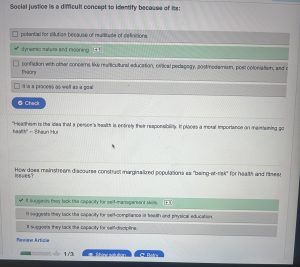

Exercise 6:
What are the implications of bodies-at-risk discourse and the refusal to understand the health gap from a social justice perspective, according to the authors of this article?
| The reading titled social justice in Kinesiology, health, and disability underscores the bodies-at-risk discourse and critiques the lack of a social justice perspective in understanding the health gap in several ways. First the article speaks about how the refusal to understand the health gap from a social justice perspective reinforced the idea that marginalized people and their bodies are a problem or a deficit in need of a cure or fix. This idea blames an individual for their inability to adhere to health norms and completely neglects to address the broader systemic issues that are actually at fault for these health disparities. Next, it is mentioned that an implication can be maintaining whiteness as the norm. Health is often centered around white upper-class people and this discourse reinforces this idea and fails to address any marginalized populations. The text states that this is a master-narrative which racializes health disparities and reinforces inequality. The lack of a social justice approach here does not account for any intersectionality and promotes a majoritarian viewpoint which further discredits marginalized populations. Another issue is Neoliberal globalization. This concept and its attempt to solve the issues, instead creates a commodity out of health which disproportionately impacts marginalized populations whilst benefiting the primarily white able-bodied dominant culture. Because a social justice perspective is not taken here the voices of marginalized people are still silenced and they are now being economically exploited. Overall, the bodies-at-risk discourse and the refusal to understand the health gap from a social justice perspective undoubtedly perpetuates inequality for marginalized populations in the sporting, and health and fitness world. Each attempt to solve the problem without a social justice perspective reinforced ableist, western viewpoints further marginalizing already marginalized populations. These implications should explain how important a social justice perspective is when addressing the health gap.
|
Section Two: Sport Feminism
Exercise 7: Notebook Prompt
What is feminism? What does it mean to you? Choose one of the images below and explain how it captures your understanding of feminism (or find one that does speak to you and paste this into your pressbook with an explanation of why it matters to you.
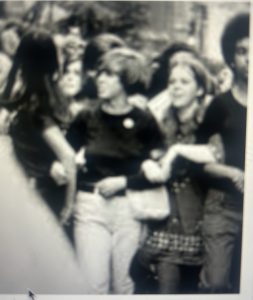 To me feminism is a movement, shared belief and a hope for social change through advocacy and education. Feminism is standing up for equal rights for all women and gender non-conforming people across the world no matter their varying backgrounds. Feminism is a way to challenge inequalities against women and gender non-conforming people in society and fight for equal respect in all realms of life. Feminism can come in a plethora of different forms including spoken word, parades, or even art. Feminism is a group fight for equality that heavily focuses on intersectionality, meaning it seeks to address how intersecting identities such as race, class, gender, etc serve to shape experiences of inequality and oppression. Feminism teaches the world about its potential to be equal and attempts to make changes so marginalized groups can thrive.The photo I chose is one of several people linking arms, walking down a street. This image explains what feminism means to me because it shows that anyone can participate in feminism and that feminism is a group movement. Some of the other images presented just showed women and people by themselves, but this photo shows all different kinds of people linking arms to fight for equality. This image highlights how men, women, young people, old people, and different races can participate in the fight for equal rights. This photo dismantles the stereotype that just women can be feminists and it shows that everyone can work together to fight for equality for all. |
Exercise 8: Notes Prompt (optional)
NB: Cornell notes is a great resource that teaches effective notetaking. Unfortunately, our system can’t save notes taken in the H5P app, so this is fully optional.
Exercise 9: Crossword Activity
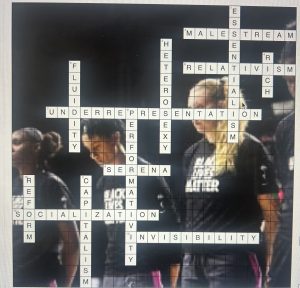
Exercise 10: Padlet Prompt
 Black Feminism:Black feminism really stuck out to me when reading this article because at first I thought all feminism was the same but I soon realized this wasn’t true. Black feminism is a type of feminism that dismantles barriers white feminism has put up by closely understanding different intersectionalities. Black women have often been marginalized in multiple settings through both gender and race and this is why they need a different approach than white feminists. Classic feminism often only considered the lives and experiences of white women, completely forgetting about all other women therefore black feminism is needed because it accounts for the women that were forgotten about in early forms of feminism.Marxist/Socialist FeminismBefore reading this article I had never heard specifically of socialist feminism but I found it very interesting. This type of feminism is an approach that explains that women’s inequality stemmed from the sexual division of labour. Since women often participated in domestic labour instead of going out of the house and making money they often missed out on several opportunities to participate in sports and leisure activities. Men were the ones that often had the opportunity to participate in these activities since they were not the ones cooking, cleaning, and looking after their children. This division of labour led to inequalities for women because they had no time to participate in sports and activities alike.Queer Theory:Queer theory explains how societal norms and expectations shape people’s perceptions on gender and sexuality. This theory was explored by famous scholars like Judith Butler and it challenges traditional categories of gender, sexuality and identity. This theory explains that power structures invented norms associated with gender and sexuality, but it is important to understand that these are just made up norms! Queer theory deconstructs binaries associated with gender and sexuality by critiquing those power structures that created such nonsense. Overall, Queer theory is used to understand and challenge how these norms are portrayed through sports and how they can be dismantled to create equality for all.
|
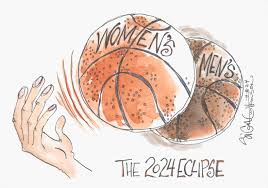
|
|


Feedback/Errata